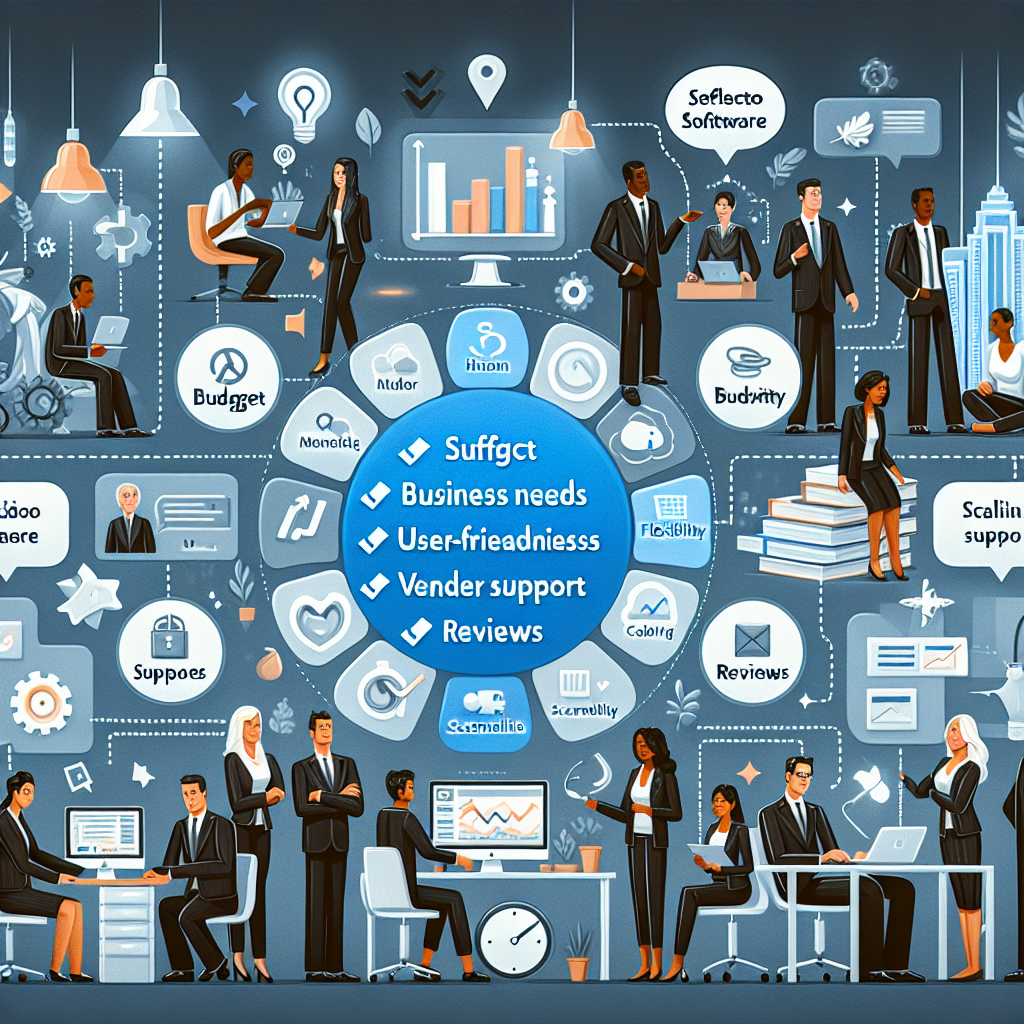-
Table of Contents
Evaluating Business Needs: Identifying Key Features and Requirements
Choosing the best software for your business is a decision that carries significant weight, as it can profoundly impact your operations, efficiency, and overall success. The process begins with a deep and honest evaluation of your business needs, a step that requires introspection and clarity. Understanding what your business truly requires is akin to understanding the very soul of your enterprise. It is about recognizing the unique challenges you face and the aspirations you hold dear. This journey of discovery is not just about identifying features; it is about aligning technology with your vision and values.
To embark on this path, start by reflecting on the core functions of your business. Consider what processes are essential to your daily operations and which areas could benefit from technological enhancement. This reflection is not merely a checklist exercise; it is an opportunity to dream about what your business could achieve with the right tools. As you delve into this introspection, engage with your team, for they are the heartbeat of your organization. Their insights and experiences can illuminate needs that may not be immediately apparent. Listening to their voices fosters a sense of unity and shared purpose, reinforcing the emotional connection between your team and the business.
Once you have a clearer understanding of your needs, the next step is to translate these into specific software features. This translation is a delicate process, akin to turning a vision into reality. It requires balancing practicality with aspiration, ensuring that the software you choose not only meets current demands but also supports future growth. Consider features that enhance productivity, streamline communication, and provide robust data analysis. These elements are not just technical specifications; they are enablers of innovation and efficiency, empowering your team to reach new heights.
As you identify these key features, it is crucial to prioritize them based on their impact on your business. This prioritization is a reflection of your strategic goals and the emotional journey you wish to undertake. It is about making choices that resonate with your long-term objectives, ensuring that the software becomes a partner in your success story. During this phase, it is also important to remain open to new possibilities. The software landscape is ever-evolving, and being receptive to emerging technologies can open doors to opportunities you may not have considered.
Furthermore, consider the scalability and flexibility of the software. Your business is a living entity, constantly growing and adapting to new challenges. The software you choose should be able to evolve alongside it, offering the flexibility to adjust to changing needs. This adaptability is not just a technical requirement; it is a testament to your commitment to resilience and innovation.
In conclusion, choosing the best software for your business is a journey that intertwines practicality with emotion, strategy with vision. It is about understanding your business at its core and selecting tools that align with your aspirations. By evaluating your needs, identifying key features, and prioritizing them thoughtfully, you lay the foundation for a partnership that can propel your business toward a future filled with promise and potential. This decision is not just about technology; it is about crafting a narrative of growth, unity, and success.
Comparing Software Options: Analyzing Costs and Benefits

Choosing the best software for your business is a decision that carries significant weight, as it can profoundly impact your company’s efficiency, productivity, and overall success. As you embark on this journey, it is essential to approach the process with a blend of analytical rigor and emotional intelligence, ensuring that the software you select aligns with both your business objectives and the needs of your team. The task of comparing software options involves a careful analysis of costs and benefits, a process that requires not only a keen eye for detail but also an understanding of the broader implications for your organization.
To begin with, it is crucial to recognize that the cost of software extends beyond the initial purchase price. While it is tempting to focus solely on upfront expenses, a more comprehensive approach considers the total cost of ownership. This includes ongoing maintenance fees, potential upgrade costs, and the resources required for implementation and training. By taking these factors into account, you can avoid the pitfall of underestimating the financial commitment involved, thereby safeguarding your business from unexpected financial strain.
Moreover, the benefits of a software solution should be evaluated not just in terms of immediate gains but also in light of long-term value. Consider how the software will enhance your business processes, improve efficiency, and contribute to achieving your strategic goals. It is important to engage with your team during this phase, as their insights and experiences can provide valuable perspectives on how the software will be utilized in day-to-day operations. By fostering an inclusive decision-making process, you can ensure that the chosen software resonates with those who will be using it most frequently, thereby enhancing adoption and satisfaction.
As you weigh the costs against the benefits, it is also essential to consider the scalability of the software. Your business is likely to evolve over time, and the software you choose should be able to grow with you. This means assessing whether the solution can accommodate an increase in users, data volume, and functionality as your business expands. A scalable solution not only protects your initial investment but also provides peace of mind, knowing that your software will continue to support your business as it reaches new heights.
In addition to scalability, the integration capabilities of the software are another critical factor to consider. The ability to seamlessly integrate with existing systems can significantly enhance the overall efficiency of your operations. This requires a thorough understanding of your current technological ecosystem and a clear vision of how the new software will fit into it. By ensuring compatibility and ease of integration, you can minimize disruptions and maximize the benefits of your new software solution.
Ultimately, the process of comparing software options is as much about understanding your business’s unique needs as it is about evaluating the features and costs of potential solutions. It requires a delicate balance of logic and emotion, as you strive to make a decision that will not only meet your immediate requirements but also support your long-term aspirations. By approaching this task with diligence and empathy, you can choose a software solution that empowers your business to thrive, fostering a sense of confidence and optimism for the future.
Ensuring Scalability and Integration: Future-Proofing Your Software Choice
Choosing the best software for your business is a decision that carries significant weight, as it can profoundly impact your company’s growth and efficiency. In today’s rapidly evolving technological landscape, ensuring scalability and integration is paramount to future-proofing your software choice. As you embark on this journey, it is essential to consider not only your current needs but also the potential for expansion and adaptation in the years to come.
The emotional investment in selecting the right software cannot be understated. It is a decision that intertwines with the very fabric of your business operations, influencing productivity, employee satisfaction, and customer experience. Therefore, it is crucial to approach this decision with a clear understanding of your business’s long-term goals and the role technology will play in achieving them. By doing so, you can ensure that the software you choose today will continue to serve your needs as your business grows and evolves.
Scalability is a critical factor in this decision-making process. As your business expands, your software must be able to accommodate increased demands without compromising performance. This means selecting a solution that can handle a growing number of users, transactions, and data without faltering. The emotional reassurance that comes from knowing your software can grow alongside your business is invaluable. It allows you to focus on strategic initiatives rather than worrying about whether your technology can keep up.
Moreover, integration capabilities are equally important. In a world where businesses rely on a multitude of software applications to manage various functions, seamless integration is essential. The ability to connect different systems and share data effortlessly can significantly enhance efficiency and reduce the risk of errors. When your software integrates smoothly with other tools, it creates a harmonious ecosystem that supports your business processes and fosters innovation. This interconnectedness not only streamlines operations but also empowers your team to work more collaboratively and creatively.
As you evaluate potential software solutions, it is vital to consider the vendor’s track record and commitment to innovation. A vendor that is dedicated to continuous improvement and staying ahead of industry trends can provide you with the confidence that your software will remain relevant and effective. This commitment to innovation ensures that your software will not only meet your current needs but also adapt to future challenges and opportunities. The emotional comfort of knowing that your software partner is invested in your success can be a powerful motivator in your decision-making process.
Furthermore, involving your team in the selection process can provide valuable insights and foster a sense of ownership and commitment. By engaging employees from various departments, you can gain a comprehensive understanding of their needs and preferences, ensuring that the chosen software aligns with their workflows and enhances their productivity. This collaborative approach not only leads to a more informed decision but also strengthens the emotional connection between your team and the technology they use daily.
In conclusion, choosing the best software for your business is a decision that requires careful consideration of scalability and integration. By focusing on these aspects, you can future-proof your software choice and ensure that it continues to support your business’s growth and success. The emotional investment in this decision is significant, but by approaching it with a clear vision and a commitment to collaboration, you can select a solution that empowers your business to thrive in an ever-changing world.
Conclusion
Choosing the best software for your business involves a thorough evaluation of your specific needs, budget, and long-term goals. Start by identifying the core requirements and challenges your business faces, and prioritize features that address these areas. Research and compare different software options, considering factors such as scalability, user-friendliness, integration capabilities, and customer support. It’s crucial to involve key stakeholders in the decision-making process to ensure the software aligns with the team’s workflow and objectives. Additionally, consider the total cost of ownership, including initial purchase, implementation, training, and ongoing maintenance. Opt for software that not only meets your current needs but can also adapt to future growth and changes in your business environment. By taking a strategic and comprehensive approach, you can select software that enhances productivity, efficiency, and overall business performance.



